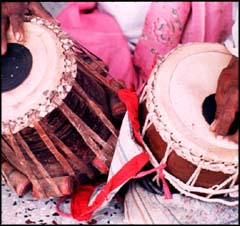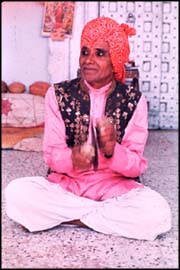Music & Instruments
Bhavai uses three types of instruments shown below. The Bhungal, the Kansijoda and the Tabla are the three principal instruments. In earlier times, the Sarangi, a stringed bow instrument was used to accompany the songs. Now a small portable keyboard called called the harmonium is used. The small Tabla drums replaced a much larger drum called the Pakharaj.
The Bhungal, a four foot long copper horn constructed in three parts is the principal instrument. Requiring varying degrees of breath and pitch control, it gives pitch for the songs and rhythm for the dance. Bhungals are only used in Bhavai theatre. They are played in pairs with a higher pitched Bhungal representing female characters and a lower pitched Bhungal symbolizing male characters. The pair provide harmony, counterpoint, and indicate sex of the characters.
The Tabla is a drum with two heads called "Bayan" and "Naraghan". Bayan is made of metal or clay and played by the left hand and Naraghan is made of wood, covered with skin and played with the right hand. The Naraghan can be tuned to the singers pitch by stretching the leather skin.
The third instrument is the Kansijoda which is made of brass and played with the fingers. It is used mainly for rhythm. Occasionally other instruments such as large drums are used for special fight sequences.
There are six basic rhythms for song and dance used in Bhavai. The specific mood of a scene determines which rhythm will be used. Songs are composed in different Ragas (keys and musical structures) according to the mood and timing of scenes. The rhythmic dialogues called chabolas and chhandas are also spoken in particular meters and pitches.
Bhavai dance is based on Gujarati folk dances such as Garba, Gasti, and Raas. Some movements are similary to Kathak dance -- a classical dance form of India. There are many variations of dance in Bhavai and each character has a particular movement or rhythm. For example, when the comic character Juthan enters, he uses comic movements of the hands, legs, waist, and face. Female characters dance with torches in their hands. Male heroic characters dance with swords. Other items such as sticks or brass plates are also used in dance.


